Amargasaurus
| Amargasaurus | |
|---|---|
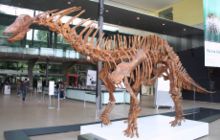
| |
| Amargasaurusskeleton cast in theMelbourne Museumfoyer. | |
| Scientific classification | |
| Domain: | Eukaryota |
| Kingdom: | Animalia |
| Phylum: | Chordata |
| Clade: | Dinosauria |
| Clade: | Saurischia |
| Clade: | †Sauropodomorpha |
| Clade: | †Sauropoda |
| Superfamily: | †Diplodocoidea |
| Family: | †Dicraeosauridae |
| Genus: | †Amargasaurus Salgado & Bonaparte, 1991 |
| Species: | †A. cazaui
|
| Binomial name | |
| †Amargasaurus cazaui | |
Amargasaurus(/əˌmɑːrɡəˈsɔːrəs/;"La Amarga lizard" ) is agenusofsauropoddinosaurfrom theEarly Cretaceousepoch(129.4–122.46mya) of what is nowArgentina.The only known skeleton was discovered in 1984 and is virtually complete, including a fragmentary skull, makingAmargasaurusone of the best-known sauropods of its epoch.Amargasauruswas firstdescribedin 1991 and contains a single knownspecies,Amargasaurus cazaui.It was a large animal, but small for a sauropod, reaching 9 to 13 meters (30 to 43 feet) in length. Most distinctively, it sported two parallel rows of tall spines down its neck and back, taller than in any other known sauropod. In life, these spines could have stuck out of the body as solitary structures that supported akeratinoussheath. An alternate hypothesis, now more favored, postulates that they could have formed a scaffold supporting askin sail.They might have been used for display, combat, or defense.
Amargasauruswas discovered insedimentary rocksof theLa Amarga Formation,which dates back to theBarremianandAptianstagesof the Early Cretaceous. Aherbivore,it shared its environment with at least three other sauropod genera, which might have exploited different food sources in order to reduce competition.Amargasaurusprobably fed at mid-height, as shown by the orientation of itsinner earand the articulation of its neck vertebrae, which suggest a habitual position of the snout 80 centimeters (31 inches) above the ground and a maximum height of 2.7 meters (8.9 feet). Within the Sauropoda,Amargasaurusis classified as a member of the familyDicraeosauridae,which differs from other sauropods in showing shorter necks and smaller body sizes.
Description
[edit]
Amargasauruswas small for a sauropod, measuring 9 to 13 meters (30 to 43 feet) in length and weighing approximately 2.6–4 metric tons (2.9–4.4 short tons).[1][2][3]: 304 [4]It followed the typical sauropodbody plan,with a long tail and neck, a small head, and a barrel-shaped trunk supported by four column-like legs. The neck ofAmargasauruswas shorter than in most other sauropods, a common trait within theDicraeosauridae.[5]Measuring 2.4 meters (7.9 feet) in length,[5]the neck corresponded to 136% of the length of the dorsalvertebral column.[6]This is comparable toDicraeosaurus(123%) but greater than in the extremely short-necked formBrachytrachelopan(75%).[6]The neck consisted of thirteencervical vertebrae,which wereopisthocoelous(convex at the front and hollow at the back), formingball-and-socket jointswith neighboring vertebrae.[2]The trunk was made out of ninedorsaland probably five fusedsacral vertebrae.[2]The foremost dorsals were opisthocoelous, while the remaining dorsals were amphiplatyan (flat on both ends).[2]Robusttransverse processes(lateral projections connecting to the ribs) indicate a strongly developed rib cage.[7]The dorsal vertebrae ofAmargasaurusand other dicraeosaurids lackedpleurocoels,the deep lateral excavations that were characteristic for other sauropods.[7]

The most striking features of the skeleton were the extremely tall, upwardly projectingneural spineson the neck and anterior dorsal vertebrae. From the third cervical onward, these neural spines were bifurcated along their entire length, forming a double row. They were circular in cross section and tapered towards their tips. The tallest spines could be found on the middle part of the neck, where they reached 60 centimeters (24 inches) on the 8th cervical.[2]On the neck, they were bowed backward, projecting above the adjacent vertebra.[3]: 304 A similar elongated neural spine has been described from the neck region of the closely relatedBajadasaurusin 2019. Unlike inAmargasaurus,this spine was bowed frontward and broadened toward the tips.[8]The last two dorsal vertebrae, the hip, and the foremost tail inAmargasaurusalso had elongated spines; these were not bifurcated but flared into a paddle-shaped upper end.[9]The pelvic region was relatively wide, judging from the long, laterally projecting transverse processes of the sacral vertebrae.[2]The forelimbs were somewhat shorter than the hind limbs, as in related sauropods. Most of the hand and foot bones were not preserved, butAmargasaurusprobably possessed five digits each as in all sauropods.[7]
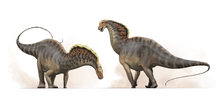
Only the rear part of the skull is preserved. It likely showed a horselike, broad snout equipped with pencil-like teeth, as seen in related sauropods for which more complete skulls are known.[10]As in other dicraeosaurids, theexternal naris(nostril opening) was situated in the posterior half of the skull, diagonally above theorbit(eye opening), which was proportionally large.[7][11]As in most other dinosaurs, the skull featured three additional openings (fenestrae). Theinfratemporal fenestra,located below the orbit, was long and narrow.[11]Behind the orbit was thesupratemporal fenestra,which in dicraeosaurids was uniquely small and can be seen when the skull is viewed from the side. This contrasts with otherdiapsid reptiles,where these openings were directed upward, thus being visible only in top view.[2]Theantorbital fenestrawould have been located in front of the eye opening, although this region is not preserved. An unusual feature were small openings seen on the backside of the skull, the so-called parietal openings orfontanelles.In othertetrapods,these openings are usually seen only in juveniles and would close as the individual grows.[12][13]Skull features shared withDicraeosaurusbut absent in most other sauropods included the fusedfrontal bonesand the notably longbasipterygoid processes,bony extensions connecting thebraincasewith thepalate.[11]
Discovery
[edit]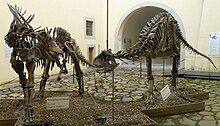
The only known skeleton (specimen numberMACN-N15) was discovered in February 1984 by Guillermo Rougier during an expedition led by Argentine paleontologistJosé Bonaparte.This was the eighth expedition of the project "Jurassic and Cretaceous Terrestrial Vertebrates of South America", which was supported by theNational Geographic Societyand initiated in 1975 to improve on the sparse knowledge of the Jurassic and Cretaceous tetrapod life of South America.[7][14]The same excursion uncovered the nearly complete skeleton of the hornedtheropodCarnotaurus.[15]The discovery site is located in the La Amargaarroyoin thePicún Leufú DepartmentofNeuquén Provincein northernPatagonia,70 kilometers (43 miles) south ofZapala.[7][16]The skeleton stems fromsedimentary rocksof theLa Amarga Formation,which dates to theBarremianthrough earlyAptianstages of the Early Cretaceous, or around 130 to 120 million years ago.[2]

The skeleton is reasonably complete and includes a partial skull. Sauropod skull bones are rarely found,[17]and theAmargasaurusskull is only the second skull known from a member of the Dicraeosauridae. Major parts of the skeleton were found in their original anatomical position: the vertebral column of the neck and back, which consisted of 22 articulated vertebrae, was found connected to both the skull and thesacrum.Of the skull, only thetemporal regionand the braincase are preserved. The sacrum, despite being partly eroded prior to burial, is fairly complete. Most of the tail is missing, with three anterior, three middle, and one posterior vertebrae being preserved, along with fragments of several others. The shoulder girdle is known from thescapula(shoulder blade) andcoracoid(which sits on the lower end of the scapula), while the pelvis is merely known from theilium(the uppermost of the three pelvic bones). The limbs are equally fragmentary, with themanus(hand) and most of thepes(foot) missing. The skeleton is currently stored in the collection of theBernardino Rivadavia Natural Sciences MuseuminBuenos Aires.[7]
The first,unofficial,mention ofAmargasaurusas a new genus of dinosaur was published by Bonaparte in the 1984 Italian bookSulle Orme dei Dinosauri.Here, the species was designated asAmargasaurus groeberi,honoringPablo Groeber,which was changed intoAmargasaurus cazauiin the official description published several years later.[18]The official description, written in Spanish, was published in 1991 byLeonardo Salgadoand Bonaparte in the Argentinianscientific journalAmeghiniana.The nameAmargasaurusalludes to the site of discovery, the La Amarga Arroyo. La Amarga is also the name of a nearby town, as well as thegeologic formationthe remains were recovered from. The wordamargaisSpanishfor "bitter", whilesaurosisGreekfor "lizard". The onespecies(A. cazaui) is named in honor of Luis Cazau, ageologistwith theYPFoilcompany, which at the time was state-owned. In 1983, Cazau informed Bonaparte's team about the paleontological significance of the La Amarga Formation, leading to the discovery of the skeleton.[7]One year later, Salgado andJorge O. Calvopublished a second paper focusing on the description of the skull.[11]
Classification
[edit]Amargasaurusis classified as a member of the Dicraeosauridae, afamilyrankedcladewithin theDiplodocoidea.Currently, this clade consists of nine species belonging to eight genera. These includeLingwulong shenqifrom the Early or Middle Jurassic of China and four species from the Late Jurassic:Brachytrachelopan mesaifrom Argentina;Suuwassea emilieaefrom theMorrison Formationof the United States; andDicraeosaurus hansemanniandDicraeosaurus sattlerifrom theTendaguru bedsofTanzania.Amargasauruswas the first dicraeosaurid known from theCretaceous,[2]although additional dicraeosaurids from the Lower Cretaceous have been described more recently, includingPilmatueia faundezi,Amargatitanis macni,andBajadasaurus pronuspinax,which are all from Argentina.[19][20][21][8]An unnamed specimen from Brazil indicates that this group persisted at least until the end of the Early Cretaceous.[2]Most analyses findDicraeosaurusandBrachytrachelopanto be more closely related to each other than toAmargasaurus.[6][22][23] Suuwasseais generally recovered as the mostbasalmember of the family.[20]: 17 [8][19]A 2015 analysis by Tschopp and colleagues came to the preliminary result that two poorly known genera from the Morrison Formation,Dyslocosaurus polyonychiusandDystrophaeus viaemalae,might be additional members of the Dicraeosauridae.[21]: 202, 214
Together with theDiplodocidaeand theRebbachisauridae,the Dicraeosauridae is nested inside theDiplodocoidea.All members of the Diplodocoidea are characterized by their box-shaped snout and narrow teeth restricted to the foremost portion of the jaws. Both the Dicraeosauridae and the Diplodocidae are characterized by bifurcated neural spines of the cervical and dorsal vertebra. In the Dicraeosauridae, the bifurcated neural spines were strongly elongated, a trend reaching its extreme inAmargasaurus.[10]
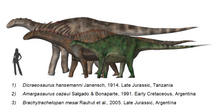
The followingcladogramby Gallina and colleagues (2019)[8]shows the presumed relationships between members of the Dicraeosauridae:
Paleobiology
[edit]Vertebral spines
[edit]
Both the function and the appearance in life of the extremely elongated and bifurcated vertebral spines remain elusive.[2]Salgado and Bonaparte, in 1991, suggested the spines represented defense weapons against predators, arguing that they tapered towards their tips. They also could have served for display, perhaps for courtship or to intimidate rivals.[7][13]Some subsequently published life restorations showed the double row of spines supporting two parallel skin sails.Gregory Paul,in 1994, considered this possibility unlikely, noting that neck sails would have reduced neck flexion, and that the spines were circular in cross-section rather than flattened as is the case in sail-bearing animals. Instead, he found that this shape indicates that the spines supported a keratinous sheath that would have extended the length of the spines in life. The spines could have been used for display or as weapons both against predators and members of the same species, as the animal might have been able to point its most anterior spines forward by bending its neck. He also hypothesized that the spines could have been clattered together to generate sound.[24]Keratinous sheaths covering the spines were also shown in a 1999 skeletal restoration published by Salgado.[12][25]
Jack Bailey, in 1997, argued that the spines resembled those ofsail-bearingpelycosaurslikeDimetrodon.According to this author,Amargasaurusmight also have possessed such a sail, which might have been used for display. Unlike those of pelycosaurs, the neural spines ofAmargasauruswere bifurcated, forming a double row along the neck and back. As the space between both rows was merely 3 to 7 cm (1.2 to 2.8 inches), the existence of two parallel sails seems unlikely. Instead, Bailey suggested the spines represented a scaffold which was completely enveloped by a single skin. Neural spines from thepenultimatedorsal vertebra to the foremost tail vertebrae also were strongly elongated, but different in structure, forming a single row of paddle-shaped projections. According to Bailey, these projections resembled those of modern humpedungulatessuch as thebison,indicating the presence of a fleshy hump above the hips. Bailey suggested similar humps for other dinosaurs with strongly elongated neural spines, such asSpinosaurusandOuranosaurus.[9]
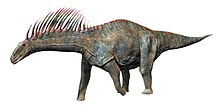
Daniela Schwarz and colleagues, in 2007, concluded that the bifurcated neural spines of diplodocids and dicraeosaurids enclosed anair sac,which would have been connected to the lungs as part of therespiratory system.InDicraeosaurus,this air sac (the so-called supravertebral diverticulum) would have rested on top of the neural arch and filled the entire space between the spines. InAmargasaurusthe upper two-thirds of the spines would have been covered by a sheath of keratin, restricting the air sac to the space between the lower one-third of the spines. A cover of either keratin or skin is indicated striations on the surface of the spines similar to those of bony horn cores of today'sbovids.[25]In 2016,Mark HallettandMathew Wedelsuggested that the backwards-directed spines might have been able to skewer predators when the neck was abruptly drawn backwards during an attack. A similar defense strategy is found in today'sgiant sable antelopeandArabian oryx,which can use their long, backwards directed horns to stab attackinglions.Apart from the possible function in defense, the spines may have been used for display, either for the intimidation of rivaling individuals or for courtship.[26]Hallett and Wedel also hypothesized that rival males might have interlocked their spines for neck wrestling.[26]Pablo Gallina and colleagues (2019) described the closely relatedBajadasaurus,which had neural spines similar to those ofAmargasaurus,and suggested that both genera employed them for defense. A defense function would have been especially effective inBajadasaurusas the spines were directed forwards and would have reached past the tip of the snout, deterring predators. The keratinous sheath that likely covered the spines might have extended their length by 50%, as seen in some moderneven-toed ungulates.Such extended sheaths would have made the delicate spines more resistant to damage—likely a critical threat, as the bases of the spines form the roof of thespinal cord.[8]
In 2022, a detailed study by Ignacio A. Cerda and colleagues analyzing the structure, morphology, and microanatomy of the vertebral spines ofAmargasaurusand an indeterminate dicraeosaurid (also from theLa Amarga Formation) suggested that the spines were not covered in a keratinous sheath as previously believed. Osteohistology of the spines suggests that they were likely, if not exclusively, covered in a sail of skin. The spines are also highly vascularized and bear cyclical growth marks, adding credence to this theory.[27]
Senses and posture
[edit]
Paulina Carabajal and colleagues, in 2014,CT-scannedthe skull, allowing for the generation of three-dimensional models of both the cranialendocast(the cast of the brain cavity) and theinner ear.Using these models, the cranial endocast was shown to encompass 94 to 98 milliliters (0.20 to 0.21 U.S. pints) in volume. The inner ear was 30 millimeters (1.2 inches) tall and 22 mm (0.87 inches) wide. Thelagena,the part containing thehair cellsfor hearing, was rather short, indicating that the sense of hearing would have been poorer inAmargasaurusthan in other sauropods for which inner ears have been studied.[28]
The first skeletal reconstructions show the skull in a near-horizontal posture. Salgado, in 1999, argued that such a posture would have been anatomically impossible due to the elongated neural spines of the neck vertebrae. Instead, he envisaged the head in a nearly vertical orientation.[12]The habitual orientation of the head is usually reflected by the orientation of thesemicircular canalsof the inner ear, which housed the sense of balance (vestibular system). Using their three-dimensional model of the inner ear, Carabajal and colleagues suggested that the snout faced downwards at an angle of roughly 65° relative to the horizontal.[28]A similar value has recently been proposed for the relatedDiplodocus.[23]The neutral posture of the neck can be approximated based on how the cervical vertebrae attached to each other. According to Carabajal and colleagues, the neck was gently sloping downwards, so that the snout would have rested 80 cm (2.6 ft) above the ground in neutral posture. In reality, neck posture would have varied according to the respective activities of the animals. Raising of the neck, e.g. for reaching an alert position, would have been constricted by the elongated neural spines, not permitting heights greater than 270 cm (8.9 ft).[28]
Locomotion
[edit]
Amargasauruswasquadrupedal(moved on four legs), and probably was unable to rear on its hind legs.[7]Salgado and Bonaparte, in 1991, suggested thatAmargasauruswas a slow walker, as both the forearms and lower legs were proportionally short, as a feature common to slow-moving animals.[7]This was contradicted by Gerardo Mazzetta and Richard Fariña in 1999, who argued thatAmargasauruswas capable of rapid locomotion. During locomotion, leg bones are strongly affected bybending moments,representing a limiting factor for the maximum speed of an animal. The leg bones ofAmargasauruswere even more sturdy than those of today'swhite rhinoceros,which is adapted togalloping.[29]
Life history
[edit]In a 2021 study, Guillermo Windholz and Ignacio Cerda obtainedthin sectionsof the humerus, femur, and a rib of theAmargasaurusspecimen in order to determine the number and spacing of lines of arrested growth (analogous to thegrowth rings of a tree). The rib showed the most complete record of lines of arrested growth, indicating that theAmargasaurusholotype individual was at least ten years old. Insauropodomorps,sexual maturityoccurred long before adult size was reached. In theouter cortex(the most external layer of the bone when seen in cross section) of theAmargasaurusindividual, lines of arrested growth are more abundant, indicating sexual maturity. However, an external fundamental system (a layer containing very closely spaced lines of arrested growth) is missing, possibly indicating that the individual was not yet fully grown, although it cannot be excluded that the external fundamental system was originally present but has since been eroded.[30]
Paleoecology
[edit]Amargasaurusstems fromsedimentary rocksof theLa Amarga Formation,which is part of theNeuquén Basinand dates to theBarremianand lateAptianof the Early Cretaceous. Most vertebrate fossils, includingAmargasaurus,have been found in the lowermost (oldest) part of the formation, the Puesto Antigual Member. This member is approximately 29 meters (95 ft) in thickness and mainly composed of sandstones deposited bybraided rivers.[31]TheAmargasaurusskeleton itself was recovered from a layer composed of sandyconglomerates.[7]The sauropod fauna of the La Amarga Formation was diverse and included the basalrebbachisauridZapalasaurus,thedicraeosauridAmargatitanis,and unnamed remains of basaltitanosauriforms.[32]The high diversity suggests that different sauropod species exploited different food sources in order to reduce competition. Basal Titanosauriforms showed proportionally longer necks, longer forelimbs, and broader tooth crowns than Dicraeosaurids and Rebbachisaurids, suggesting greater feeding heights.[28]Amargasaurusprobably fed above ground level at heights of up to 2.7 meters (8.9 ft), as evidenced by the anatomy of its neck and inner ear. Rebbachisaurids likeZapalasauruspresumably fed at ground-level, while basal Titanosauriforms exploited food sources at higher levels.[28]
Other dinosaurs of the La Amarga Formation include an indeterminatestegosaur;[33]predatory dinosaurs include the smallceratosaurLigabueino,and the presence of a largetetanuranis indicated by teeth. Other than dinosaurs, the formation is notable for thecladotherianmammalVincelestes,the only mammal known from the Early Cretaceous of South America.[32]Crocodylomorphsare represented by thetrematochampsidAmargasuchus– theholotypeof this genus was found in association with theAmargasaurusbones.[16]
References
[edit]- ^Mazzetta, G.V.; P. Christiansen; R.A. Farina (2004). "Giants and bizarres: body size of some southern South American Cretaceous dinosaurs".Historical Biology.16(2–4): 71–83.Bibcode:2004HBio...16...71M.CiteSeerX10.1.1.694.1650.doi:10.1080/08912960410001715132.S2CID56028251.
- ^abcdefghijklNovas, F.E. (2009).The age of dinosaurs in South America.Bloomington: Indiana University Press. pp. 172–174.ISBN978-0-253-35289-7.
- ^abUpchurch, P.; Barrett, P. M.; Dodson, P. (2004). "Sauropoda". In Weishampel, D.B.; Dodson, P.; Osmolska, H. (eds.).The Dinosauria(2nd ed.). Berkeley: University of California Press. pp. 259–322.
- ^Paul, Gregory S. (2016).The Princeton Field Guide to Dinosaurs.Princeton University Press. p. 210.ISBN978-1-78684-190-2.OCLC985402380.
- ^abSenter, P. (2007)."Necks for sex: sexual selection as an explanation for sauropod dinosaur neck elongation"(PDF).Journal of Zoology.271(1): 45–53.doi:10.1111/j.1469-7998.2006.00197.x.
- ^abcRauhut, O. W. M.; Remes, K.; Fechner, R.; Cladera, G.; Puerta, P. (2005). "Discovery of a short-necked sauropod dinosaur from the Late Jurassic period of Patagonia".Nature.435(7042): 670–672.Bibcode:2005Natur.435..670R.doi:10.1038/nature03623.PMID15931221.S2CID4385136.
- ^abcdefghijklSalgado, L.; Bonaparte, J. F. (1991). "Un nuevo sauropodo Dicraeosauridae,Amargasaurus cazauigen. et sp. nov., de la Formacion La Amarga, Neocomiano de la Provincia del Neuquén, Argentina ".Ameghiniana(in Spanish).28(3–4): 333–346.
- ^abcdeGallina, P.A.; Apesteguía, S.; Canale, J.I.; Haluza, A. (2019)."A new long-spined dinosaur from Patagonia sheds light on sauropod defense system".Scientific Reports.9(1): 1392.Bibcode:2019NatSR...9.1392G.doi:10.1038/s41598-018-37943-3.PMC6362061.PMID30718633.
- ^abBailey, J. B. (1997). "Neural spine elongation in dinosaurs: sailbacks or buffalo-backs?".Journal of Paleontology.71(6): 1124–1146.Bibcode:1997JPal...71.1124B.doi:10.1017/S0022336000036076.JSTOR1306608.S2CID130861276.
- ^abWilson, J. (2005). "Overview of sauropod phylogeny and evolution". In Rogers, K. C.; Wilson, J. (eds.).The sauropods: Evolution and paleobiology.University of California Press. pp. 15–49.ISBN978-0-520-24623-2.
- ^abcdSalgado, L.; Calvo, J. O. (1992). "Cranial osteology ofAmargasaurus cazauiSalgado and Bonaparte (Sauropoda, Dicraeosauridae) from the Neocomian of Patagonia ".Ameghiniana.29(4): 337–346.
- ^abcSalgado, L. (1999). "The macroevolution of the Diplodocimorpha (Dinosauria; Sauropoda): A developmental model".Ameghiniana.36(2): 203–216.
- ^abSalgado, L.; Coria, R.A. (2005). "Sauropods of Patagonia: Systematic update and notes on global sauropod evolution". In Tidwell, V.; Carpenter, K. (eds.).Thunder-Lizards: The sauropodomorph dinosaurs.Indiana University Press. pp. 430–453.ISBN978-0-253-34542-4.
- ^Bonaparte, J.F. (1981). "Jurassic and Cretaceous terrestrial vertebrates of South America".National Geographic Society Research Reports, 1975 Projects:115–125.
- ^Bonaparte, J.F.; Novas, F.E.; Coria, R. A. (1990)."Carnotaurus sastreiBonaparte, the horned, lightly built carnosaur from the Middle Cretaceous of Patagonia "(PDF).Contributions in Science.416:1–42.doi:10.5962/p.226819.S2CID132580445.Archived fromthe original(PDF)on July 21, 2010.RetrievedJuly 25,2015.
- ^abChiappe, L.M. (1988). "A new trematochampsid crocodile from the Early Cretaceous of north-western Patagonia, Argentina and its palaeobiogeographical and phylogenetic implications".Cretaceous Research.9(4): 379–389.Bibcode:1988CrRes...9..379C.doi:10.1016/0195-6671(88)90009-2.
- ^Chure, D.; Britt, B. B.; Whitlock, J. A.; Wilson, J. A. (2010)."First complete sauropod dinosaur skull from the Cretaceous of the Americas and the evolution of sauropod dentition".Naturwissenschaften.97(4): 379–391.Bibcode:2010NW.....97..379C.doi:10.1007/s00114-010-0650-6.ISSN0028-1042.PMC2841758.PMID20179896.
- ^Glut, D. F. (1997)."Amargasaurus".Dinosaurs, the encyclopedia.McFarland & Company, Inc. Publishers. pp.121–124.ISBN978-0-375-82419-7.
- ^abXing Xu; Paul Upchurch; Philip D. Mannion; Paul M. Barrett; Omar R. Regalado-Fernandez; Jinyou Mo; Jinfu Ma; Hongan Liu (2018)."A new Middle Jurassic diplodocoid suggests an earlier dispersal and diversification of sauropod dinosaurs".Nature Communications.9(1): Article number 2700.Bibcode:2018NatCo...9.2700X.doi:10.1038/s41467-018-05128-1.PMC6057878.PMID30042444.
- ^abWhitlock, J. A. (2011)."A phylogenetic analysis of Diplodocoidea (Saurischia: Sauropoda)".Zoological Journal of the Linnean Society.161(4): 872–915.doi:10.1111/j.1096-3642.2010.00665.x.ISSN1096-3642.
- ^abTschopp, E.; Mateus, O.; Benson, R.B.J. (2015)."A specimen-level phylogenetic analysis and taxonomic revision of Diplodocidae (Dinosauria, Sauropoda)".PeerJ.3:e857.doi:10.7717/peerj.857.PMC4393826.PMID25870766.
- ^Taylor, M. P.; Naish, D. (2005). "The phylogenetic taxonomy of Diplodocoidea (Dinosauria: Sauropoda)".PaleoBios.25(2): 1–7.S2CID17873254.
- ^abSereno, P. C.; Wilson, J. A.; Witmer, L. M.; Whitlock, J. A.; Maga, A.; Oumarou, Ide; Timothy, A. R. (2007)."Structural extremes in a Cretaceous dinosaur".PLOS ONE.2(11): e1230.Bibcode:2007PLoSO...2.1230S.doi:10.1371/journal.pone.0001230.PMC2077925.PMID18030355.
- ^Paul, G. S. (1994)."Dinosaur art & restoration notes:Dicraeosaurs"(PDF).The Dinosaur Report.8.Archived(PDF)from the original on March 16, 2021.RetrievedFebruary 22,2019.
- ^abSchwarz, D.; Frey, E.; Meyer, C. A. (2007)."Pneumaticity and soft-tissue reconstructions in the neck of diplodocid and dicraeosaurid sauropods"(PDF).Acta Palaeontologica Polonica.52(1).Archived(PDF)from the original on November 3, 2016.RetrievedJuly 27,2015.
- ^abHallett, M.; Wedel, M. J. (2016).The Sauropod Dinosaurs: Life in the age of giants.Johns Hopkins University Press. pp. 201–202 and 224.ISBN978-1-4214-2029-5.
- ^Cerda, Ignacio A.; Novas, Fernando E.; Carballido, José Luis; Salgado, Leonardo (March 24, 2022)."Osteohistology of the hyperelongate hemispinous processes ofAmargasaurus cazaui(Dinosauria: Sauropoda): Implications for soft tissue reconstruction and functional significance ".Journal of Anatomy.240(6): 1005–1019.doi:10.1111/joa.13659.ISSN0021-8782.PMC9119615.PMID35332552.S2CID247677750.
- ^abcdePaulina Carabajal, A.; Carballido, J.L.; Currie, P.J. (2014). "Braincase, neuroanatomy, and neck posture ofAmargasaurus cazaui(Sauropoda, Dicraeosauridae) and its implications for understanding head posture in sauropods ".Journal of Vertebrate Paleontology.34(4): 870–882.Bibcode:2014JVPal..34..870P.doi:10.1080/02724634.2014.838174.hdl:11336/19365.S2CID85748606.
- ^Mazzetta, G.V.; Farina, R.A. (1999). "Estimacion de la capacidad atlética deAmargasaurus cazauiSalgado y Bonaparte, 1991, yCarnotaurus sastreiBonaparte, 1985 (Saurischia, Sauropoda-Theropoda) ".Ameghiniana(in Spanish).36(1): 105–106.
- ^Windholz, G.J.; Cerda, I.A. (2021)."Paleohistology of two dicraeosaurid dinosaurs (Sauropoda; Diplodocoidea) from La Amarga Formation (Barremian–Aptian, Lower Cretaceous), Neuquén Basin, Argentina: Paleobiological implications".Cretaceous Research.128:104965.Bibcode:2021CrRes.12804965W.doi:10.1016/j.cretres.2021.104965.ISSN0195-6671.
- ^Leanza, H.A.; Apesteguı́a, S.; Novas, F.E.; de la Fuente, Marcelo S (2004). "Cretaceous terrestrial beds from the Neuquén Basin (Argentina) and their tetrapod assemblages".Cretaceous Research.25(1): 61–87.Bibcode:2004CrRes..25...61L.doi:10.1016/j.cretres.2003.10.005.ISSN0195-6671.
- ^abApesteguía, S. (2007). "The sauropod diversity of the La Amarga Formation (Barremian), Neuquén (Argentina)".Gondwana Research.12(4): 533–546.Bibcode:2007GondR..12..533A.doi:10.1016/j.gr.2007.04.007.
- ^Ulansky, R. E. (2014)."Dinosaurs classification. Basal Thyreophora & Stegosauria"(PDF).Dinologia:1–8.Archived(PDF)from the original on December 22, 2019.RetrievedAugust 3,2015.
External links
[edit]- Dicraeosaurids
- Aptian genus extinctions
- Barremian genus first appearances
- Early Cretaceous dinosaurs of South America
- Cretaceous Argentina
- Fossils of Argentina
- La Amarga Formation
- Fossil taxa described in 1991
- Taxa named by José Bonaparte
- Early Cretaceous sauropods
- Sauropods of South America
- Monotypic sauropod genera












